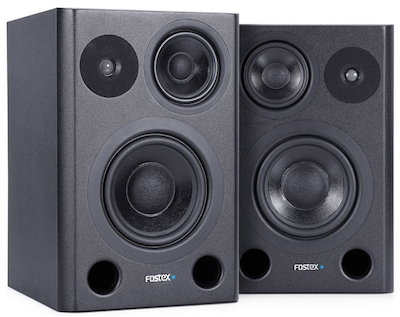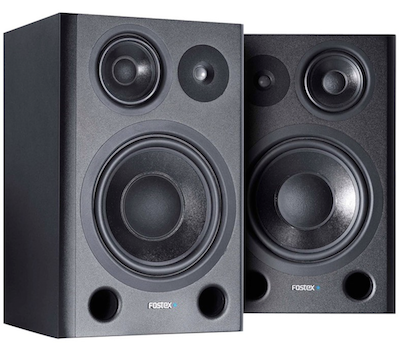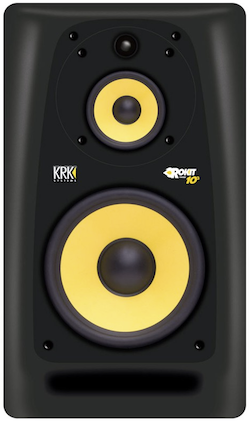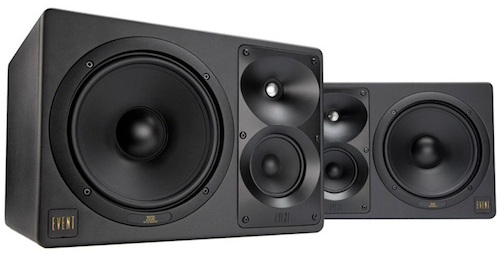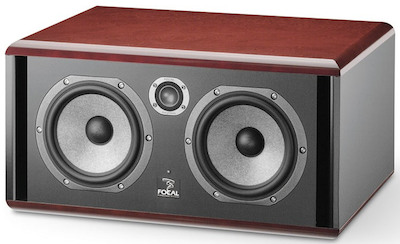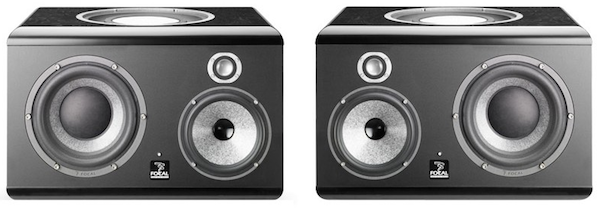FANCY A THREE-WAY?!! - SPEAKER GUIDE
Posted on Thu 04 July 2013 in entries
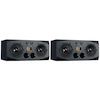 With more and more manufacturers entering the three-way speaker market, we thought that we'd write an article to bring you up to speed with these relatively misunderstood studio fixtures. What are the advantages of using a three-way speaker design? How do they differ from traditional speakers? We'll also look at some example three-way speakers on the current market so that hopefully by the time you've read this article, you'll be a mini-expert on the three-way phenomenon!
With more and more manufacturers entering the three-way speaker market, we thought that we'd write an article to bring you up to speed with these relatively misunderstood studio fixtures. What are the advantages of using a three-way speaker design? How do they differ from traditional speakers? We'll also look at some example three-way speakers on the current market so that hopefully by the time you've read this article, you'll be a mini-expert on the three-way phenomenon!
'TWO WAY' vs 'THREE-WAY' - WHAT DOES IT EVEN MEAN?
If you've ever looked at a two-way speaker side-by-side with a three-way speaker then you've probably already worked out the difference between them. In fact, you may have even worked it out from the names! A traditional two-way speaker is comprised of two drivers (which usually look like a shallow, indented circular cone with a small circular protruding dome in the middle), whereas a three-way speaker... (you guessed it!)... features three of these drivers.
So, these drivers that we mentioned are the parts of the speaker that move to then move the air to create the sounds that we hear. But why do we need more than one of them?
Indeed, you will find certain types of speakers that do just have a single driver, but you will find that they don't reproduce the entire frequency spectrum (from low to high) very well. If you've ever heard a subwoofer (a special speaker designed to just create low frequencies) in isolation then you will have experienced this effect for yourself.
Subwoofers are generally designed with a single large driver. If you listen to a song solely through a subwoofer, you'll quickly realise that things don't sound right. You'll get a brilliant, deep bass response, but above about 150Hz, everything will start to sound extremely muffled and above 200Hz, you're unlikely to get any signal at all. Consider that the upper limit of human hearing extends to approximately 20,000Hz and that's a lot of the song that you're missing out on! Why do subwoofers act like this though?
The answer to this question has a lot to do with the driver. The sub driver is designed to be large and powerful in order to move the air forcefully in order to create big bass sounds (bass sounds have low frequencies and large wavelengths). Because the driver is large and usually quite thick, it cannot vibrate fast enough to reproduce higher frequencies; remember, to produce even a 1000Hz sound it would need to vibrate no less than 1000 times every second.
Sure, you can design a smaller, more delicate driver that is capable of vibrating fast enough to produce much higher frequencies, up to and even beyond the limits of human hearing, but in this case you get the opposite problem... the drivers aren't large enough or powerful enough to produce lower frequencies effectively.
So, surely the answer is to look somewhere in the middle? Find a driver size that produces both adequate bass and high frequencies? If only it were that simple! With a speaker with a one-driver design, you are always going to have to make significant compromises, because even with today's technology, there is not a driver that is both big and powerful enough to reproduce bass frequencies, yet small and delicate enough to produce sparkling high frequencies.
So, the logical step when designing a speaker was therefore to include both types of driver. One larger, more durable driver can be used to recreate bass and mid-range frequencies and one smaller driver can be used at the same time to produce higher frequencies. (There are of course other design features such as bass ports that can be used to increase the bass response of smaller speakers, but we're not going to go into all that in this article. If you want to learn more about speaker design then there is plenty of information out there on the internet and in books.) By using two drivers, you're sharing out the workload of the speaker in order to reproduce the entire frequency range of human hearing.
Ok, so hopefully you've managed to understand what I have explained so far (if not, please feel free to ask questions in the comment section below) and if you are up to speed, you may well be wondering what the point of adding a third driver is if we can recreate everything we need with just two. Well, by adding more drivers, the speaker designer can customise each one in order to perform a more specific task. For example, one driver can deal with a very specific section of bass frequencies; a second, smaller driver can be optimised to reproduce detailed mid-range frequencies and then a third, even smaller driver can be designed for the sole purpose of reproducing clear high frequencies. By allocating set frequency ranges to specific drivers that are optimised for reproducing sound within these limits, three-way speakers allow you to reproduce more detailed audio across the entire spectrum.
Prominent mid-range sounds tend to include things like vocals, pianos, guitars, lead synth sounds, brass instruments, etc. and so this is an area that will play a prominent part in the majority of projects. Therefore, it makes sense to have a dedicated driver that is optimised for producing and giving separation to these types of sounds, which should then allow you to make more informed decisions at the mix stage.
Ok, so because of this design, a three-way speaker sounds better than a two-way speaker right? Unfortunately the answer to that question isn't always a straightforward 'yes'...
There are many factors that influence how 'good' a speaker sounds, ranging from the cabinet design (shape and material), crossover design and accuracy (dealing with allocating frequencies to the relevant driver) and even personal preference. Whilst adding a third driver to a speaker should theoretically produce better sonic results, that is certainly not to say that a pair of £500 three-way speakers will sound better than a pair of £2000 two-way speakers! However, if you are on the market for some monitors and have a budget that fits in with a pair of three-ways, I'd certainly recommend comparing them to some two-ways around the same price. At the end of the day, your decision will come down to personal preference but there a plenty of people out there that swear by three-ways!
If you live near our Bournemouth pro-music studio then we have a special acoustically-designed showroom (designed by acoustician Andy Munro, who helped design the sE Munro Egg monitors), so feel free to come in and demo the monitors of your choice (please contact us before you come down to check our stock). Alternatively, if you want to take a set of speakers home and try them in your own studio, please give us a call on 01202 597180 to learn more about our try-before-you-buy service.
Ok, so now you're aware of the advantages of a three-way design, we'll take a brief look at some of the three-way speakers that we stock...
At less than £400 for a pair, Fostex PM641s give you a fantastic way to enter the three-way market on a budget and they really do sound great. In preparation for this review I did a little fishing around to gain various opinions from my colleagues and all that had heard them agreed that the PM641s offered superb value for money.
PM641 monitors come as a pair with one speaker designed for use on the right and the other for use on the left. The main reason for this is that the mid and high driver sit next to each other above the low driver, rather than being stacking one on top of the other. This helps keep the physical size of the speaker to a minimum, meaning that they shouldn't seem out of place in even very small home studios.
For the price, the PM641s give a very detailed sound across the entire spectrum, obviously helped by the fact that they have that additional driver to give further separation to the mids. With a 6.5 inch low driver and bass ports, they can also get down to a deep 55Hz and their high-frequency driver extends way past the upper limit of human hearing to 25kHz.
Overall, the PM641s are a set of speakers that you simply must try if they fit in and around your budget because in terms of clarity, they really do sound very special for a £400-a-pair set of active monitors and you'll struggle to find anything better at this price point - you can even bag them from us in a money-saving bundle with a set of ISOacoustics desktop stands (CLICK HERE)!
At just £100 more than the PM641s, the PM841s are for those that want a bit more bass! With a larger 8 inch driver, the PM841s can get down to 50Hz. If you're after a set of three-way monitors on a budget and require something big in the bass department then these are likely to be just what you're looking for. However, at this price point you can also get a pair of two-way studio monitors aimed at the professional market for not much more. A set of Adam A5Xs or Focal CMS 40s will only cost around £50 more for a pair and although they don't sound as powerful as the Fostex's in the bass range, being aimed more at the pro-studio market, they do provide a more balanced high-frequency response.
So, it's a toss up between low and high response as well as budget when it comes to considering three-way monitors at this price point. Of course, if you're local to our Bournemouth pro-music superstore then we would advise you to come in and demo some speakers before you buy them so that you can get an idea of which will be best for you.
For more information on Fostex PM641 or PM841 three-way monitors, click the links below or give us a call on 01202 597180.
Fostex PM641 Three-way Monitors (Pair) - More Info/Buy
Fostex PM841 Three-way Monitors (Pair) - More Info/Buy
Fostex PM641s (Pair) with Desktop Stands Bundle - SAVE £££s!!! - More Info/Buy
Fostex PM841s (Pair) with Desktop Stands Bundle - SAVE £££s!!! - More Info/Buy
Just like other KRKs, the RP10-3s are big and bassy! In fact, they can pump out sound right down to 35Hz, which pretty much negates the need for a sub even if you're producing music destined for the dancefloor! If you're into drum and bass, dubstep, hip hop, etc., you like the general sound of the KRK RP8s but require more clarity in the mid-range then these will most certainly not disappoint! The mid and high driver are also located on a special rotating plate, which allows you to position the speakers either horizontally or vertically depending on your preference and still get maximum performance out of them.
There are however a couple of things to consider with the 10-3s... the first is that they are big... very big for a studio monitor! If you work in a very small space then they probably aren't going to be suitable because they really will dwarf everything else!
The second thing to consider is that at this price point you will be able to afford a set of Adam A7Xs or Focal CMS 50s. Whilst the KRK 10-3s offer very good stereo imaging and a noticeable improvement in mid-range clarity compared to their Rokit Powered two-way siblings, both the Adams and Focals offer a more balanced sound over the entire frequency spectrum so should allow you to make more detailed mixing decisions, especially in higher bands. Neither can stretch down to the impressive bass depths of the KRK 10-3s though, so if monitoring in the bass range is one of your primary concerns, the 10-3s are extremely likely to float your boat.
For more information on KRK RP10-3 three-way monitors, click the link below or give us a call on 01202 597180.
KRK RP10-3 Three-way Monitor (Single) - More Info/Buy
For under £800 a pair, Event 2030s offer very high quality indeed. The inclusion of the third driver means that you get great clarity in the lows, mids and highs and we've even heard people mention that they find them sonically close to Event's superb Opal speakers! We say that whilst the Opal is most certainly a superior monitor, the 2030s sound a lot more expensive than their price tag suggests and you will be able to achieve some really great sounding mixes on them. The fact that their lower end goes right down to 38Hz will also be of great use to those making bass-heavy club music.
Event 2030s have a very smooth response and whilst they are not quite as detailed in the very top end as the Adams or indeed the Focals, as with many three-way speakers, they do have superior stereo imaging due to their third driver giving more separation in the mids. This makes it much easier to place sounds within a mix in terms of the stereo field, which can be really useful for polishing off a mix.
For more information on Event 2030 three-way monitors, click the link below or give us a call on 01202 597180.
Event 2030 Three-way Monitors (Pair) - More Info/Buy
Eve's SC speakers use DSP (Digital Signal Processing) in order to optimise their performance, which goes some way to explain why these speakers have such a smooth sound. As you would expect from a pair of three-way speakers, the Eve SC305s and SC307s have an excellent mid-range response and provide superb stereo imaging. It's also worth noting that these speakers have a nice tight-sounding bass (with the SC307s getting down to 40Hz and the smaller SC305s still able to reach 50Hz). All-in-all, Eve's SC three-way monitors are a pleasure to mix on and highly suitable for long listening sessions as they aren't as fatiguing as many other monitors out there... in fact, they are one of the smoothest monitors I've ever heard!
Given the design, appearance and price-tag of the Eve SC307s, you're probably intrigued to learn how they compare to the Adam A77Xs. Well, side-by-side, the Eve's certainly sound smoother and this is no doubt down to their precision digital design features. However, that said, it's difficult to say whether this makes the Eve's 'better'! In fact, whilst I have no doubt that plenty of people will prefer the sound of the Eve's (after all, their monitors are held in extremely high regard in the industry), I think that I slightly preferred the rougher, bassier sound of the Adams with their all-analogue signal path. However, I have no doubt that you'd be able to get excellent mixes from a set of either of these speakers as they both have great, highly-detailed qualities to them so it's all going to come down to personal preference in the end.
I'm a sucker for that bassy Adam sound and love what their X-ART tweeter does, so although I would say that the A77Xs are a better speaker for me, I wouldn't say that they are a 'better' overall speaker compared to the Eves. I can appreciate both for what they are and to me, asking which is the 'best' one is like asking 'what's the best colour out of blue and red?'. Different people will have different opinions.
For more information on Eve SC305 and SC307 three-way monitors, click the links below or give us a call on 01202 597180.
Eve SC305 Three-way Monitors (Pair) - More Info/Buy
Eve SC307 Three-way Monitors (Pair) - More Info/Buy
Eve SC305 Three-way Monitor (Single) - More Info/Buy
Eve SC307 Three-way Monitor (Single) - More Info/Buy
Now at less than £1200 for a pair, these beastly speakers simply have to be considered if they lie within your budget. Adam's standard AX range of two-way speakers are an extremely popular choice for semi-pro and professional producers working in a variety of different genres, from rock, to pop, to dance, to hip hop, to drum and bass and pretty much everything inbetween! Their popularity lies in their detailed sound, excellent frequency response and of course that X-ART tweeter, which takes their upper limit all the way up to an astonishing 50kHz! Now, we know that this goes way beyond the limits of human hearing, but if you've ever heard the X-ART tweeter then you're likely to agree that it definitely does something magical to those high frequencies!
So, if you've ever listened to a set of Adam A7X or A8X speakers, the A77Xs, with their two 7 inch drivers can be described as giving a similar sound, but with more bass and more clarity in the mid range (which is a great compliment considering that I think that two-way AX speakers are already nicely detailed in this range). This just goes to prove what a pleasantly surprising difference that third driver can make if implemented well.
Like many three-way speakers, the A77Xs come in pairs, with one designed for placement on the left-hand side and the other for placement on the right side. In my opinion they are an absolutely superb speaker for the money and would be suitable for mixing pretty much any genre of music you can think of!
For more information on Adam A77X three-way monitors and our money-saving bundles, click the links below or give us a call on 01202 597180.
Adam A77X Three-way Monitors (Pair) - More Info/Buy
Adam A77X (Pair) & Desktop Stands Bundle - SAVE £££s!!! - More Info/Buy
Adam A77X (Pair), Sub10 Mk2 & Desktop Stands Bundle - SAVE £££s!!! - More Info/Buy
I still remember how everyone's jaw hit the floor when we first got the Twin 6s on demo in our store. I think it's fair to say that they sound superb!
People tend to be drawn to the Focal sound due to their precise detail across the whole frequency range, plus their non-fatiguing nature, which means that you can easily sit and listen to these for long sessions without a break.
Twin 6 BEs have fantastic stereo imaging. If you sit in front of a properly positioned pair with your eyes closed and listen to a well-mixed song, you can pick out exactly where each band member would be positioned if they were on a stage in front of you! This quality makes them fantastic for mixing on.
The only downside to the Twin 6 BEs is their price, and whilst you really do get what you pay for in terms of sound, since Adam released their A77Xs, there has been a competing product on the market at half the price!
The disadvantage of the A77X is that some people find that the X-ART tweeter can be quite fatiguing for long mixing sessions and I would still say that the stereo imaging on the Focals is slightly better than you get with the Adams. However, the A77X's have an extended bass response (you should have no need for a sub with them) and seem to have a little more presence in the lower high-frequencies, which some people can prefer. The only real way to find out which you prefer is to demo them!
For more information on Focal Twin 6 BE three-way monitors, click the link below or give us a call on 01202 597180.
Focal Twin 6 BE Three-way Monitor (Single) - More Info/Buy
From our experience, these are some of, if not the best speakers out there for under £5k. The price may seem steep to some, but if you've heard them, you'll know that you're getting what you pay for. The SM9s compete with some speakers that cost twice their price, so when you consider this, their price tag is actually very reasonable! Still, you'll need a room that's been acoustically treated in order to really reap their rewards.
The SM9s have a really big bottom end; they can get down to a stomach-rumbling 30Hz! The even more impressive thing is that this bottom end is not produced by tuned ports as all the other speakers in this article are; it naturally reaches these depths!
In fact, across their entire audible range (up to a spec'd 40kHz), the SM9s produce a superbly detailed sound with a flat response. You'll be able to pick up tiny details in your mix on these bad boys that most other speakers will miss and once again, if you close your eyes and listen to a good mix, you'll be able to pick out just where each performer is positioned on the virtual stage in front of you. Every customer to date that has purchased a set of these from us has reported their best ever mixes!
Focal SM9s are actually constructed with a water tight casing and whilst this doesn't mean that you should take them swimming, it does help maintain an equal pressure in the cab along with the passive radiator.
Focal SM9s even allow you to switch to a two-way mode, which allows you to get a slightly different mix perspective; a very handy feature indeed! Most of the time you'll probably want that third driver operational though, just to give that extra sonic clarity in the mid range. If you're after a really serious set of monitors for producing top-quality mixes and you're budget is around £4500-£5000 then you're going to struggle to find anything better than these.
For more information on Focal SM9 three-way monitors, click the link below or give us a call on 01202 597180.
Focal SM9 Three-way Monitors (Pair) - More Info/Buy
SUMMARY
Well, we hope that this article has taught you something new and that you're now fully aware of why the three-way speaker design exists. Three-way speakers are becoming more and more popular for a very good reason and with a number of reasonably priced three-ways now available, the good news is that they are no longer just for top-end recording studios that require more mid-range clarity.
If you are interested in adding a set of three-way monitors to your studio and fancy demoing some before you buy then please feel free to visit our Bournemouth pro-music superstore or give us a call on 01202 597180 to check our stock. Remember, we currently have Europe's only purpose-built monitor auditioning room, designed by acoustician Andy Munro, so it's an ideal environment to put studio monitors through their paces. CLICK HERE for for more information on our superstore store.
If you have any additional questions on three-way monitors or would like pre-sales advice then please feel free to click the relevant links in this article, give us a call on 01202 597180 or leave comments below. Thanks for reading!

